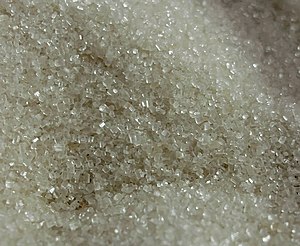 Image via WikipediaServing Size
Image via WikipediaServing SizeThis size is based on the recommended amount per item, based on the USDA food pyramid. Similar food items will have similar serving sizes, thus making it easier to compare 2 foods of the same category. Paying attention to serving size can be very valuable, as many people are surprised that servings of fruits and vegetables may be larger than they expected, while a serving of grains may be smaller (this is due to the caloric content of various foods - some are denser than others).
% Daily Value
This indicates how the vitamins and minerals in a food product will fit in a 2,000 calorie diet. This will help you to understand if the food has a lot, or just a little of the important nutrients. (Keep in mind that NOT everyone should eat a 2,000 calorie diet - your correct caloric intake depends on a variety of factors, including height, weight, and daily activity level, as well as whether you are trying to lose weight or gain it, so remember that when looking at the nutrition label, this is just a guideline, as you may eat more or less than 2,000 calories per day. Here is a quick tip for finding out how many calories you need per day: If you get 30 minutes of daily exercise, you need to consume about 15 calories per pound of body weight, to maintain your current weight (less if you are trying to lose weight, OR if you get less exercise; more if trying to gain, or if you get more exercise). For example, if you get 30 minutes of exercise per day, and you weigh 120lbs, you need about 1800 calories per day to maintain your current weight.)
The middle section
The nutrients you'll find listed in the middle section are some of the ones most important to your health. This information can help you to calculate your daily limit of fat, fiber, sodium, sugar, and other nutrients. (However, you will want to make sure you DON'T just rely on this section - you will also want to make sure you read the ingredients! Some items naturally contain sugar or sodium, while others have these ingredients added. Just because an item says it contains "2 g" of sugar doesn't necessarily mean there is sugar added - it may be naturally occurring in - for example - dried or fresh fruit, etc. It is also important to watch out for artificial ingredients, many of which may be very harmful to your health, and these won't show up in this section of the label.)
Vitamins & minerals
The percent daily value found here is the U.S. Recommended Daily Allowance for vitamins and minerals. (This may help in your choosing of supplements, but most processed foods do not contain that many vitamins and minerals - keep in mind you may need much more of these than the RDA - the RDA is the MINIMUM to avoid a deficiency disease only - it does not mean that is what you need for optimum health.)
Ingredients
Now we get to the largest, and usually most important part of the label. Anytime you buy a processed food product, you should ALWAYS read the ingredients! You may be shocked to find out some of the stuff that is added to your food. Watch out for (and try to avoid) artificial sweeteners, artificial colors and flavors, and excess preservatives. Not sure what all of these might be named? They can go by a lot of different names, but as a general rule of thumb, if you can't pronounce it, don't eat it! Long chemical-sounding names are best avoided. Stick with whole, real food ingredients that you recognize. Also, the ingredients are listed in descending order, from the largest amount to the smallest, so the first few ingredients on the
 Image via Wikipedialabel constitute the majority of the product. (Watch out for sugar here! Sugar is a sneaky one, as it goes by so many names - sometimes there are 4 or more kinds of sugar in one product - keep an eye out for sugars in the first few ingredients on the label - especially if there are multiple types - this means the majority of the product consists of sugar! High-fructose corn syrup is typically easy to spot, but some of the others may not be. If in doubt, keep an eye out for the "-ose" -- e.g. sucrose, lactose, fructose, etc. - these are all sugars.)
Image via Wikipedialabel constitute the majority of the product. (Watch out for sugar here! Sugar is a sneaky one, as it goes by so many names - sometimes there are 4 or more kinds of sugar in one product - keep an eye out for sugars in the first few ingredients on the label - especially if there are multiple types - this means the majority of the product consists of sugar! High-fructose corn syrup is typically easy to spot, but some of the others may not be. If in doubt, keep an eye out for the "-ose" -- e.g. sucrose, lactose, fructose, etc. - these are all sugars.)In a hurry? Here is a really quick helpful tip for reading ingredients labels: The fewer ingredients the better.
More ingredients means more junk added to your food. Even just glancing at the label to see if it is short or long, can help you eat healthier! In general, the more processed the food, the longer the list of ingredients. And you may be surprised how many things are added to the simplest items.
For example, did you know that most "sour cream" now sold in grocery stores is not cream at all? REAL sour cream contains just 2 ingredients (at most): cultured cream, and salt. (Some leave out the salt, and some list the cream separate from the culture - so it may say "cream and enzymes," or something similar.) Many brands of "sour cream" on store shelves now have 5 or 6 ingredients, and cream is not even at the top! Not good. Steer clear of these overly processed brands if you can. (In terms of sour cream, Daisy and a few store brands still make the real stuff.)
Now that you know what the nutrition label actually means, it'll be a lot easier to make healthy food choices.

No comments:
Post a Comment
We welcome comments and suggestions!